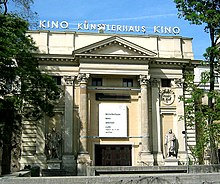Вена Кюнстлерхаус

Кюнстлерхаус зоне в 1 -м районе Вену разместил Ассоциацию Кюнстлерхауса с 1868 года. Она расположена в Кольцевой дороги между Академестрассе, Бесендорферштрасс и Мусиквереинплатц.
Здание было построено между 1865 и 1868 годами и с тех пор служило выставочным пространством и местом мероприятия. В 2015 году были разделены акции между двумя владельцами, а Haselsteiner Familien-Privatstiftung в качестве акционера и Künstlerhaus Vereinigung , Gesellschaft Bildender Künstlerinnen Und Künstler österreichs, самая старая существующая ассоциация артистов в авторской, в качестве участника меньшего. В 1949 году кино перемещалось в западное крыло здания. По состоянию на 2013 год этот кинотеатр работает как Stadtkino im Künstlerhaus и является одним из просмотра проведения ежегодного кинофестиваля в Венейле . Кроме того, в 1974 году в Восточном крыле был основан театр, который в последний раз управлял Брутом до 2017 года.
Между осенью 2016 года и весной 2020 года Künstlerhaus столкнулся с серьезным ремонтом. Во время реконструкции бывший Альтманн «Текстлфабрик» в Венском-Маргаретене (Столбергассе 26) служил в качестве временного размещения. Недавно отремонтированный Künstlerhaus был вновь открыт 6 марта 2020 года. Сегодня Künstlerhaus Vereinigung представляет свои выставки на верхнем этаже здания, в то время как Albertina Modern, которая впервые открыла свои двери 27 мая 2020 - и подземный этаж. Таким образом, Künstlerhaus теперь является домом для двух независимых культурных учреждений.
History of the society
[ редактировать ]The society has its roots in the suburb of Laimgrube, now part of Mariahilf. Here, on the site of a guesthouse, Leopold Ernst had a Neo-Gothic festival hall built (at a great loss) in 1847.[1] The hall became the meeting place of the Society of Young Artists and Academics, which was founded in 1851 and later renamed the Albrecht Dürer Society.[2]
In 1861 it merged with another artists' society, Eintracht, to form a new association representing Viennese painters, sculptors and architects: the Vienna Artists' Society. In 1868 the society moved into its current premises. In 1897 a number of modern artists seceded from the Künstlerhaus and founded the Vienna Secession.[citation needed]
In 1972 the society opened its membership to practitioners of applied art, and in 1976 it was renamed the "Austrian Artists' Society, Künstlerhaus". Since 1983 the Society has included filmmakers and audio-visual artists among its members. Its limited company (Künstlerhaus-Ges. m. b. H.), founded in 1985, organises exhibitions both for the Künstlerhaus and for other museums and institutions.[3]
History of the building
[edit]
The architect of the building was August Weber (1836–1903).[4] Several types of Austrian stone were used, supplied by the Viennese firm Anton Wasserburger. Emperor Franz Joseph I laid the keystone.[5]
Opened on 1 September 1868 as one of the earliest Ringstraße buildings, it was designed in the style of an Italian Renaissance villa, after Jacopo Sansovino. At the time, it stood next to the banks of the Wien River, which still flowed openly in the city. The building was significantly expanded as early as 1882 with a pair of side wings. These were later used to house a cinema (from 1949) and a theatre (from 1974). Also in 1882, the Society held the "First International Art Exhibition in the Künstlerhaus". The inner garden was roofed over in 1888.
In the 20th century, real estate observers speculated that the Society was under pressure to demolish the building in favor of something larger, as it is unusually low-rise for the Ringstraße area, or to rebuild it. For example, the "Kaym-Hetmanek Plan"[1][6] in the early 1930s proposed to replace the historic pavilion with eight-storey apartment blocks.[citation needed] The recommendations of an architectural planning competition for Karlsplatz in 1946 showed that the city of Vienna considered the Künstlerhaus, as well as the Office of Transport building, as expendable. In 1956–57 the Society modernised the Stiftersaal room.
In 1966, Karl Schwanzer proposed a plan to build large offices for IBM on the site of the Künstlerhaus, which met with widespread objections among residents and the media. The previous year, protests had followed the decision to tear down the old Florianikirche.[7] The Society preserved the Künstlerhaus.
In the 21st century, new plans have been discussed to expand and rebuild the Künstlerhaus, so as to integrate it more closely into the "museum cluster" on Karlsplatz. For example, in July 2010 Beppo Mauhart proposed the addition of two new buildings to this site.[8]
References
[edit]- ^ Jump up to: a b Gerd Pichler, Rezension: Wladimir Aichelburg, Das Wiener Künstlerhaus 1861–2001 Kunsthistoriker aktuell, 2003. (in German)
- ^ Walter Koschatzky: Rudolf von Alt, 2nd edition, Böhlau, Vienna, 2001, ISBN 3-205-99397-7, p.214 (limited preview, p. 214, at Google Books). (in German)
- ^ "Künstlerhaus", Austria Forum, 12 March 2010. (in German)
- ^ Das Künstlerhaus in Wien In: Allgemeine Bauzeitung, 1881. With diagrams and pictures. From Anno (Austrian Newspapers Online). (in German)
- ^ Die Geschichte des Wiener Künstlerhauses: Das geistige Antlitz – 100 Jahre Künstlerhaus 1861–1961 Archived 17 October 2010 at the Wayback Machine Walther Maria Neuwirth; history of the Künstlerhaus written to commemorate its 100-year anniversary. (in German)
- ^ Franz Kaym Architektenlexikon, Architekturzentrum Wien. (in German)
- ^ "Historisches über den 5. Bezirk" Archived 6 July 2011 at the Wayback Machine, Vienna Online, 4 April 2008. (in German)
- ^ "Neue Pläne für das Künstlerhaus", Die Presse, 15 July 2010. (in German)
Дальнейшее чтение
[ редактировать ]- Вильгельм Рюдигер (редактор): молодое искусство в немецкой империи. Ehrlich & Schmidt, Вена, 1943. (на немецком языке)
- Айхельбург, Wladimir (2003). Wiener Künstlerhaus 1861–2001 (на немецком языке). Вена: Австрийский Кунст- и Культурверлаг. ISBN 3-85437-189-6 Полем OCLC 51805108 .
- Shadiwy, Robert (2005). Городские изображения: размышления об изменениях в архитектуре и городских исследованиях (на немецком языке). Lit. 978-3-8258-7755-2 Полем Получено 7 мая 2022 года .
